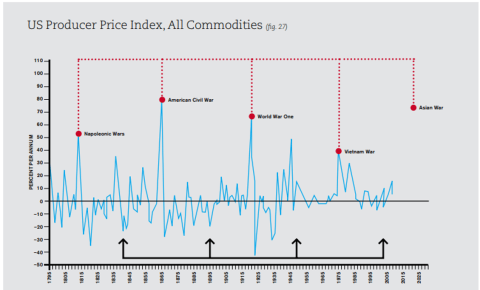Dear Arkite Subscriber,
In our continual process of evolution and enhancement, we have introduced a process where we update our predictions with relevant news flow, as to how they are unfolding. To explain this process if you have been following the story of cluster munitions closely in the Murrination sections in these two articles:
The Battle for Ukraine 48; The Challenges Of The Phase 3 Break In
The Battle for Ukraine 51; NATO is Doing Too Little and Too Late
you'll see at the bottom of these posts a section called ARTICLES AND COMMENTARY POST PUBLICATION. Here I follow up my predictions with relevant updates. You can see when a Murrination has been updated with the date in the blue block below the title of the post, as shown on the screen grab below, and every Friday there is a newsletter sent out containing the most recent updated posts. Sometimes predictions are months old but are updated over time and this allows you to follow the evolution of my predictions.
I would greatly value your feedback on this process, as its is designed to track predictions over time with relevant news and information. The string below is from The Battle for Ukraine 48; The Challenges Of The Phase 3 Break In which is tracking progress of the counter offensive:
ARTICLES AND COMMENTARY POST PUBLICATION-FOLLOW THE PROGRESS OF THE COUNTER OFFENSIVE HERE
07 July 2023 What are cluster munitions? How they could change the Ukraine war. Cluster munitions shift destruction from a single point artillery detonation, to one that can cover a much larger area. They are the grandchildren of the shrapnel shell and are most effective against exposed troops or those defending trenches without top cover, such as the defensive system that the Russians now occupy. Their down side is that some of the bomblets (2%) might not explode leaving them as a risk to civilians at the wars ends. But first the war has to be won, and these weapons are effective;
1. In clearing the vast minefields set up by Russia
2. In destroying and then allowing the assault the defensive trench systems.
3. In destroying Russian armoured formations that could be used as a reserve to plug a break through
4. Increase the availability of ammunition with some 3 million rounds in the American arsenal that will be transferred to Ukraine.
5. Allow Ukrainian artillery to shoot and scoot by firing three rounds on target and then to move , avoiding what has become a much shorts Russian counter battery kill china of only three to five minutes.
6. Many of the three millions such cluster munitions are forward deployed in American and allied bases in Europe, so will quickly be seen on the battlefield. The rest will come from South Korea.
7. They are principally 155mm M864 NATO cluster rounds each with 88 bomblets (the size of a 40mm M42/46 grenade), capable of covering an area of about 30,000 square metres. They could also be fired from the American high-mobility artillery rocket system (Himars).
8. Each bomblet is 81mm high and 38mm in diameter designed as an anti-personnel and anti-armour system
This weapons provision is another example of too little too late, as it has only come after the Spring offensive in the south has ground to a halt and Ukraine lives and vital equipment has been lost. So the question is when will Biden administration shift from the costly just in time support strategy to one of being ahead of the curve giving Ukraine with its dwindling manpower resources the chance to win in decisive action?
02 July 2023 US may send banned cluster bombs to Ukraine to help counter Russia’s superiority in long-range weapons. Kyiv has been asking for cluster munitions that are compatible with Himars precision rocket launchers as well as 155mm artillery howitzers. The White House has renewed its consideration because of the Ukrainian struggle to make major gains in its counter-offensive and such area munitions are especially capable against dug-in Russian positions without top cover such as open trenches, with a destructive foot print as large as up to three football fields.
02 July 2023 Russia has ramped up use of deadly kamikaze drone to blunt Ukraine’s offensive The Lancet, the low-cost Unmanned loitering Aerial attack Vehicle with a 3 kg warhead and 30km range , has become a particular problem for Ukrainian troops along the front lines. Especially for Ukrainian artillerymen, with many describing them as one of the main threats on the battlefield, as there is no easy way to defend against the drones because of their ability to manoeuvre. The only counter are better electronic jamming capabilities and better SHORAD capabilities such as the German-made Flankpanzer Gepard AA-vhecial, armed with a pair of 35 mm Oerlikon anti-aircraft cannons, which are one of the weapons that could take down such drones. Berlin earlier this week promised to send 45 (to add to the 40 or so already in Ukraine) more of its self-propelled anti-aircraft guns to Kyiv by the end of 2023. (RUSI) wrote: "In general, gun systems are preferred over missiles where possible due to the much lower cost per engagement and higher availability of ammunition compared with SAMs and MANPADS".
The Gepards in Ukraine have turned out to be very effective against Shahed-136 drones; the radar can detect them 16 kilometres (9.9 mi) away and it takes as few as six rounds to shoot them down with a similar number needed to destroy a cruise missile. One of the Gepards downed 10 Shaheds in a single engagement.RUSI noted that the Gepards were particularly effective against the drones. Ukraine allegedly suffered its first Gepard loss in April 2023 to a Lancet loitering munition., although the full video shows the Gepard relatively intact after the impact.
The only other systems that systems that could be provided to Ukraine is the American Mobile Short Range Air Defense, or M-SHORAD, systems, which are based on the 8x8 Stryker wheeled armoured vehicle (RHS). The US Army is also already looking to complement the M-SHORAD system with a Stryker-mounted laser directed energy weapon for added defence, especially against small drones, as well as incoming missiles, artillery shells and rockets, and mortar projectiles.
23 June 2023 The very limited gains so far on the southern front are shown below, suggesting that the Ukrainians are refining their tactics and waiting for more SAM systems and new cluster munitions to arrive before regaining the momentum in attack.
21 June 2023 Volodymyr Zelensky says Ukraine's counter-offensive going slower than desired The rate of progress since the June 5th start has been slower than generally expected due to the strength of Russian air power. The one clear risk that we outlined that had to be negated, but which seems to have not been due to lack of SAM systems able to provide SHORAD (see below) against helicopter and fighter attacks. At the same time the Ukraine’s forces on the southern front have been for two weeks engaged in relatively limited methodical attacks to roll back the first line of defences and in the process have been learning to conduct combined arms warfare without the key element of close air support.
Naturally Putin is Jubilant! But as only 3 out of the 12 assault brigades (with probably only 1 of the 9 western brigades)being so far committed his sentiment is premature. Notably and consistent with our outflanking theory, Yevgeny Prigozhin, accused the military of hiding reports that Ukrainian troops are trying to cross the Dnipro to the east, an area that was flooded by dam water but has since dried out. Whilst Russia has moved forces out of this region to support the southern flanks' defences. We note that we are still only in phase 2 of the battle, and Ukraine deception planning will no doubt still be in operation shrouding the planning of the main battle thrust yet to come.
20 June 2023 Classified US intelligence documents leaked on the internet in April said the Challengers were assigned to a new unit called the 82nd Air Assault Brigade. The same documents showed the brigade was also equipped with German Marder tracked fighting vehicles and American Strykers armoured personnel carriers.
20 June 2023 Ukraine repulsed by Russian Kamov Ka-52 (AKA the alligator)attack helicopters Our concerns that NATO has not provided sufficient air defence systems (especially mobile short range systems SHORAD) to Ukraine seems to have been borne out in the recent combat phase of combat since 5th June on the southern front. As Russia have been using it's attack helicopter fleet mainly comprising the highly capable Kamov Ka-52 (AKA the alligator) attack helicopters to deadly effect. “There are constant attacks from helicopters, three or four times a day,” one Ukraine solder reported, describing the Russians’ deadly use of Ka-52 attack helicopters around the frontline, and admitting they are difficult to shoot down from the ground, eluding his forces efforts on the battlefield.
The impact of these attack helicopters which can operate at night, has been the pay off for the Russian strategy of pinning down the limited Ukrainian medium and long range SAM systems to defend their cities. In response there has been a rush by NATO nations to provide SHORAD systems swiftly into the field. Notably led by the UK, US Denmark and Netherlands. purchasing “hundreds of short and medium range air defence systems”, largely Soviet era, to be delivered in the coming weeks. So that the Ka-52 threat can be negated.
The desperate Ukrainian pleas for the west to provide Ukraine with US Apache attack choppers, in addition to F-16 fighter jets can now be put into stark context.
20 June 2023 Russia redeploys forces from southern Ukraine after Kakhovka dam collapse The Ministry of Defence said Moscow had begun moving elements of its Dnipro forces to reinforce its troops in Bakhmut, a war-ravaged town in eastern Ukraine, and the Zaporizhzhia region, the area in southern Ukraine that is likely to see the main thrust of Kyiv’s counteroffensive. “This potentially involves several thousand troops from the 49th army, including its 34th separate motorised brigade, as well as airborne forces and naval infantry units,” the MoD said. “The redeployment likely reflects Russia’s perception that a major Ukrainian attack across the Dnipro is now less likely following the collapse of Kakhovka dam and the resulting flooding.” Which are the conditions that we described above for a flaking attack by Ukraine.
Feedback your thoughts here



































